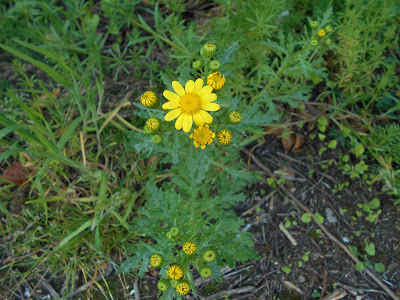I picked her up from Jacqui's house and set out, with Bing as tugging at the lead, as lively as a cricket. She is an epic sniffer and will pause at any number of posts, trees or even tussocks of grass.
We maintained a cracking pace, and, as there are still areas of Daventry I barely know, I decided to take a roundabout route to my house on Stefen Hill, going via the Royal Oak industrial estate. It would, I felt, run some of the steam out of Bing.
The term 'industrial estate' suggests a rather uninteresting, even grim, area for a wildlife enthusiast such as me, but there are still large area of open grassy fields yet to be built upon. Hundreds of plants of Lady's Smock, Cardamine pratensis, were present, reminding us that this was once meadowland. In a month or so I would not be at all surprised to find an orchid or two in this area.
 |
Open areas on the Royal Oak industrial estate are studded with
Lady's Smock. Daventry, 8 May, 2018
|
But even where buildings were present the scene was brightened with species such as Oxford Ragwort, Senecio squalidus. Although the specific epithet implies it is a plant of squalid places this is not always the case and it certainly provides a splash of colour wherever it grows, and as a bonus it is also the food plant of the Cinnabar Moth.
 |
Plants of Oxford Ragwort brightened up waste ground and roadsides.
Royal Oak, Daventry. 8 May, 2018
|
Hawthorn, Crataegus monogyna, bushes were covered with a froth of blossom so, with May out I can cast a clout. And as the temperature rises later in the day the plants should be visited by numerous insects including many which will induce the development of galls.
 |
Hawthorn (May) is at its finest. Royal Oak Industrial Estate, Daventry.
8 May, 2018
|
A little further on in fact a few hawthorn bushes did have grossly distorted leaves but this was not the work of insects but was caused by a fungus, Taphrina crataegi.
As we entered The Grange housing estate I expected to see the last of any meadow flowers so I was delighted to find that in a neglected garden dozens of Lady's Smocks were in bloom. Please, whoever you are, don't mow for a while.
 |
Taphrina crataegi was causing the distortion of hawthorn leaves in
The Grange area, Daventry. 8 May, 2018
|
As we entered The Grange housing estate I expected to see the last of any meadow flowers so I was delighted to find that in a neglected garden dozens of Lady's Smocks were in bloom. Please, whoever you are, don't mow for a while.
 |
Delightfully neglected gardens provided a habitat for Lady's Smock.
The Grange, Daventry. 8 May, 2018
|
Perhaps even more surprising, in the shade of a relict hedgerow, a Wood Anemone was in flower! Again it was evidence that, perhaps as recently as the 1970's, this area was still open countryside or even woodland.
 |
Even a Wood Anemone had survived. The Grange, Daventry.
8 May, 2018
|
But by and large traces of the original vegetation had disappeared, to be replaced by ruderal plants such as groundsel, shepherd's purse and Herb Robert, Geranium robertianum. The word Geranium is derived from the Latin geranos, a crane, the seeds taking the form of a long, beak-like structure and leading to the name Cranesbill being applied to the genus.
 |
Herb Robert, a pretty if smelly weed. The Grange, Daventry.
8 May, 2018
|
And that was about it, with Bing now trotting gently alongside me, much of her earlier energy having been burned off. There was just time to photograph a plant superficially like a white bluebell (not a true oxymoron I suppose) but which was in fact a type of onion.
 |
Also smelly is this onion relative, Three-cornered Leek. The Grange,
Daventry. 8 May, 2018
|
The Three-cornered Leek, Allium triquetrum, is a native of the west Mediterranean region (and, perhaps, the Channel Islands) but has become thoroughly naturalised in southern Britain, being first recorded in 1759, and seems to be steadily on the increase. I gather that it has been a nuisance at the Chelsea Physic Garden for years and here it was trying to escape from a garden.
 |
A closer look shows the green stripe down each 'petal', typical of onions.
The Grange, Daventry. 8 May, 2018
|
If anyone offers me a clump I'll say 'Thank you very much, but no.' Spreading by both seeds and bulbs it would soon become unwelcome, as it was a few years ago in our garden in Byfield.
Tony White. E-mail: diaea@yahoo.co.uk
No comments:
Post a Comment